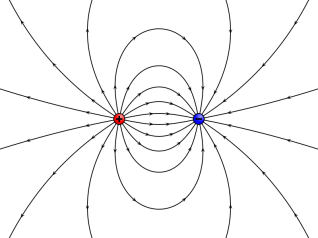When a charged particle experiences an acceleration, a time-varying electromagnetic field is set up. The acceleration can be the result of the application of an electric field (-field), (called a potential difference or voltage), or from a time-varying -field component of an electromagnetic wave, or from interactions with other charged particles.
The electric field between two (positive +q and negative -q) charged particles can be visualized as a dense radial distribution of imaginary strings or lines connecting each particle, and such network is called an electric dipole moment p, image below.
 At the instant a charge begins to accelerate, the electric field surrounding the charge is altered in the vicinity of the charge, like a ripple, which propagates out into space at the speed of light c or v in the case of a material. For small perturbations, whereby the electron gently oscillates about its mean position, the restoring force is
At the instant a charge begins to accelerate, the electric field surrounding the charge is altered in the vicinity of the charge, like a ripple, which propagates out into space at the speed of light c or v in the case of a material. For small perturbations, whereby the electron gently oscillates about its mean position, the restoring force is
The negative sign indicates that a driving force in one direction will result in a restoring force in the opposite direction, once the angular frequency ω is greater than the resonance frequency 
 Here,
Here, ![]() is the natural or resonant frequency of the atoms bound electron.
is the natural or resonant frequency of the atoms bound electron.
A material is composed of an astronomical number of polarisable atoms. When a time-varying periodic function (a light wave) impinges on a such a medium, electrons will be driven into forced oscillations. When such an event happens, electromagnetic ripples begin to emanate out from the atoms, with a characteristic frequency depending on the electronic transitional energies.
Electromagnetic fields are generated in a radio antenna. A radio antenna is a conductor which is a specific length and shape, such that the fields are of a defined wavelength and shape. The process involves the application of an alternating voltage at a terminal of the conductor. The alternating voltage produces an alternating electron current, were by electrons are set into frequency varying periodic oscillations. Such motion of these charged particles sets up an electromagnetic field in the vicinity of the antenna. Thus, the frequency of the electromagnetic field at any instant in time, will depend on the particles oscillation frequency at that particular moment in time. The higher the angular frequency of the particle, the shorter the wavelength and the greater the transfer of electromagnetic energy (Poynting vector). The fields direction vector will be strongest perpendicular to the axis of the particles vibration. The following scenario provides a description of how a light wave encountering an atomic bound electron is driven into simple harmonic motion.
The following scenario provides a description of how a light wave encountering an atomic bound electron is driven into simple harmonic motion.
Newton’s second law of motion states that when a force acts on a particle, the particle will accelerate in the direction of the applied force. Consider an impinging light wave to be the driving force behind the acceleration of the bound electron
The forces experienced by the particle include the driving force of the light wave, the restoring force experience by the electron and the damping force, corresponding to each proceeding term in the equation
 This equation represents the driving force of the E-field component and the restoring force
This equation represents the driving force of the E-field component and the restoring force
The cosine function can be replaced with an exponential term for simplification
As we can see from the cosine function in the equation, the electron should oscillate up and down once the electromagnetic wave interacts with it. The following equation describes the position of the electron along the x-axis with respect to time
The velocity of the particle with respect to time is
The acceleration of the particle with respect to time is
Substitution of yields









